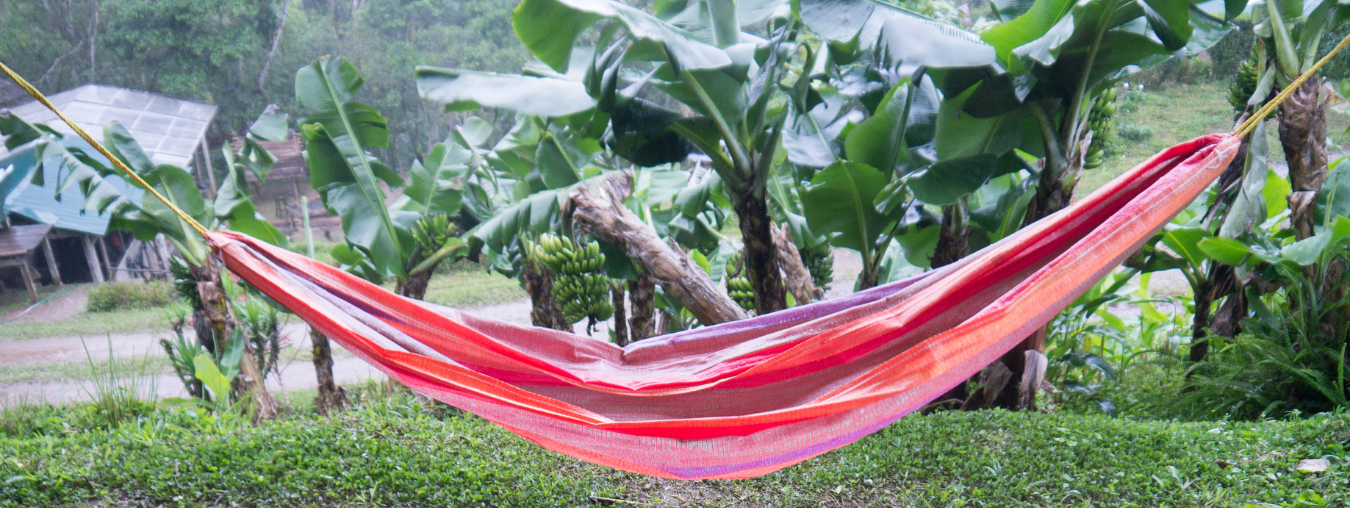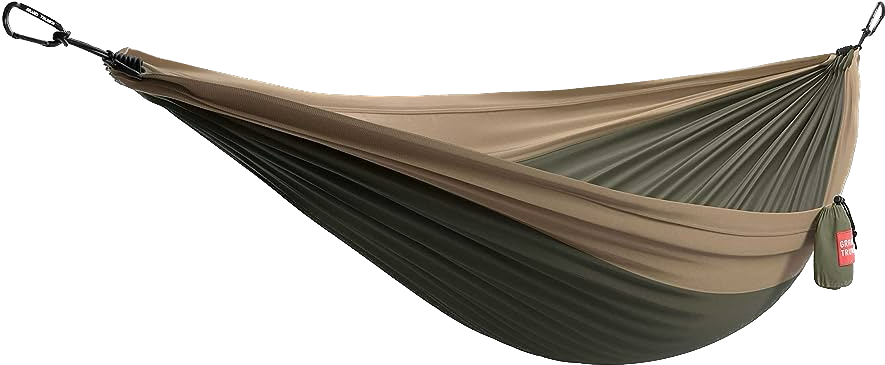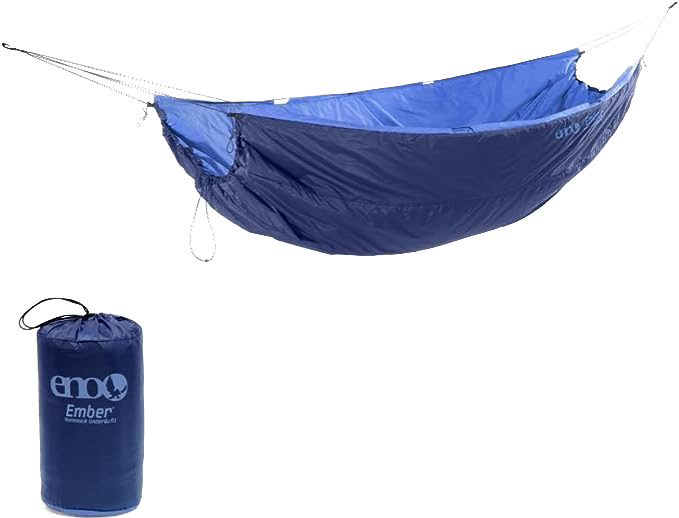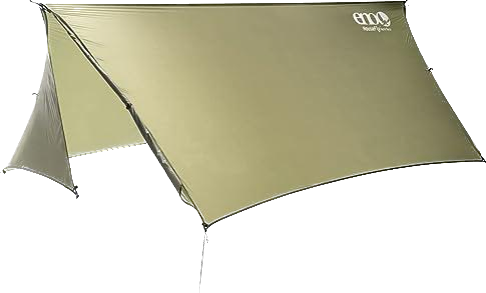Hammocks are a popular outdoor relaxation option, but what happens when the weather takes a turn for the wetter? Can hammocks be left out in the rain, or do they need to be taken down and stored away until the sun comes back out?
A hammock can be left outside in the rain and some hammocks have been designed to be weather-resistant. However, over time rain can damage a hammock if it is not properly protected. Hammocks made from natural fibers like cotton and rope may not hold up as well in wet weather and ultimately can develop mold or mildew.
If you decide to leave your hammock outside – especially during wet weather, it’s important to consider the potential risks and take steps to protect your hammock. In this article, we’ll explore the factors that can affect the durability of a hammock in the rain and provide tips on how to care for your hammock to ensure it lasts for seasons to come.
Materials and Weather Resistance

The material of a hammock can play a big role in its ability to withstand wet weather. Natural fibers, such as cotton and rope, are more prone to mold and mildew and may not hold up as well in the rain as synthetic materials like nylon or polyester. Hammocks made with waterproof or water-resistant materials are a good choice if you live in an area with frequent rain or plan to leave your hammock outside for extended periods of time. It’s also a good idea to look for a hammock with a weather-resistant finish or coating to help it shed water and resist fading.
If you frequently experience wet weather or plan on leaving your hammock outside you will want to ensure you pick a hammock that will last. That said, there are a few factors to consider when choosing a hammock material that will be able to withstand wet conditions:
- Water resistance: Some materials, such as nylon or polyester, are naturally water resistant, which means they are less likely to absorb water and will dry off more quickly than other materials.
- Durability: Hammocks made with nylon, canvas, or other synthetic materials, are more resistant to wear and tear and will be less likely to break down or become damaged in wet conditions.
- Quick-drying: Materials that are able to dry quickly, such as mesh or thin strips of fabric, will be less likely to stay wet and become moldy or mildewed in wet conditions.
Overall, nylon and polyester are both great options for hammocks that will be used in wet conditions, as they are both water-resistant and durable. Mesh or thin strips of fabric can also be a good choice if you want a hammock that will dry quickly.
Proper Storage and Maintenance
Even if your hammock is made with weather-resistant materials, it’s still a good idea to take steps to protect it from the rain. If you can’t bring your hammock inside during wet weather, consider storing it under a covered area like a porch or gazebo. This will help keep the hammock dry and prevent water from pooling on the fabric, which can lead to mold and mildew. If your hammock does get wet, be sure to hang it up to dry completely before using it again to prevent mold and mildew growth. Regular cleaning and maintenance can also help extend the life of your hammock.
Protecting Your Hammock from the Elements
For those who do choose to leave their hammocks outside, try investing in a hammock cover or tarp. These tarps are designed to handle rain, snow, and other weather conditions. While they aren’t nearly as effective as storing your hammock indoors, they can protect your hammock from water damage and other effects of the weather. Just be sure to regularly check on your hammock prior to using it, and keep an eye out for any mildew that may develop.
In addition, you can use tree straps or stand-alone hammock stands that allow you to adjust the height and angle of your hammock. This can help prevent water from pooling on the fabric and allow the hammock to drain more easily.
For freezing temperatures or snowy weather, it’s probably best to just bring your hammock indoors. While it might be tempting, you shouldn’t leave your hammock in the snow as it could cause hammock materials to freeze, stretch, and weaken.
What Happens If A Hammock Gets Wet in the Rain?
Hammocks can easily handle getting wet every now and then without any issues. However, hammocks should not be left in the rain and snow for long periods of time.
There are some issues related to water that can reduce the lifespan of your hammock, so keeping it dry most of the time is key to prolonging its useful life for many years. Let’s dive into some of those water-related issues.
Bad smell
If your hammock gets wet and stays like this for some time, odors will accumulate and the hammock will develop a pretty unpleasant aroma. This usually happens when you don’t allow your hammock to dry, especially before storing it.
Also, if you leave your hammock stored for a long period without making sure it’s in a dry and well-ventilated place, moisture might accumulate and cause the same problem.
Mold
Mold is another serious problem your hammock can develop if you don’t allow it to dry well after being exposed to rain or dampness. If your hammock is not completely dried and you store it for a long time, it’ll most likely develop mold and mildew.
The main problem with mold is that it can weaken the fabric of your hammock over time, and if you don’t get rid of mold quickly, this will lead to the following problem.
If you suspect mold or mildew check out this article from HGTV on cleaning a fabric hammock.
Fabric weakening
Mold and moisture buildup can damage your hammock when it’s exposed to these conditions for too long. The fibers will become weaker and more likely to break, so if you have left your hammock in the rain too many times, it’s a good idea to check for issues in the structure of your hammock.
Can I use a tarp to protect my hammock from rain?
Although it’s common to see people using tarps suspended over their hammocks to “protect” them for long periods, this practice is not recommended, since even under a tarp your hammock can accumulate moisture and end up developing mold and odors. This also applies if you want to store your hammock in an airtight plastic container in rainy conditions.
Now, a tarp is always a good option to protect you and your hammock from the rain when you are hammocking outdoors. A properly sized tarp (about 12 ft long) will help prevent pools of water from forming anywhere in your hammock, as well as provide sufficient ventilation to prevent too much moisture from condensing, especially at night. If you’re considering hammocking during a storm, you should check out our resource about hammock safety during lightning storms. This guide will talk through the do’s and do not’s when you’re hammock camping in a storm.
How Do You Dry A Wet Hammock?
The most recommended method to dry your hammock is air drying. In addition to being effective, this method is also less aggressive on the fibers. With this method, hammocks usually dry in about 30 minutes,
To apply this method simply:
- Lay out your hammock by hanging from each end the same way you’d with your sheets
- Wait around 30 minutes and check if your hammock has dried completely
Can I Use A Machine Dryer?
Drying a hammock in a dryer is not recommended, as excessive heat can weaken the fibers, increasing the chance of ripping. This is true for both camping hammocks made from nylon, as well as hammocks made from organic materials such as cotton.
While cotton and woven hammocks may better withstand tumble drying – with warm water and a light setting – this also depends on the characteristics of each hammock; for example, whether it includes removable spreader bars, the thickness of the fabric, etc.
Keep in mind that a hammock that’s too heavy can end up damaging your dryer, so it’s important to check the hammock’s instructions and avoid taking unnecessary risks.
What To Do If a Hammock Develops Mold or Mildew
A small amount of mold in your hammock is not necessarily a serious problem, as long as you catch it in time. If you do happen to find mold in your hammock you can take the following steps to treat it:
- Mix a little warm water with a light detergent in a bucket or container.
- Place the hammock in a bathtub and use a mildly abrasive brush to remove any mildew.
- Hang the hammock on your patio to air dry
Alternatively, you can:
- Prepare a solution of vinegar and water in a ratio of 50/50
- Apply the vinegar solution on the hammock and wait around 30 min
- Wash the hammock as indicated in the previous steps and put it to air dry
If the mold is very resistant, you can alternatively use baking soda instead of vinegar and water solution and follow the previous steps.
Hammocks that spend a long time in storage can experience moisture built up, and develop a more serious problem of mold – potentially rendering the hammock unusable.
For this reason, if your hammock is going to spend a long time in storage, it’s very important that you store your hammock indoors in a place free of moisture; you should check it frequently to ensure that it doesn’t have any traces of mold.
What Hammocks Do Best In Rain?
Although some brands claim to make hammocks in special fabrics resistant to rain and moisture, the reality is that no hammock is completely waterproof or rainproof.
All types of hammocks made of synthetic fibers (e.g., nylon taffeta) or organic (cotton, linen, etc) can develop mold due to excessive moisture accumulation. However, the type of fabric and the design play a key role in making a hammock more or less resistant to rain.
In either case, the essential element for a hammock to resist well in light to moderate rain is that it dries very quickly.
For this reason, hammocks made with fibers such as nylon, usually withstand rain well because this material dries in approx 30 min, somewhat faster than other types of hammocks.
Can I Leave My Hammock Stand Outside?
Although the more solid parts of your hammock such as the stand should – theoretically – be able to stay outside, without proper treatment, even this part of your hammock can be vulnerable to rain. Even if you have a stainless steel stand, it’d end up damaged over time from water corrosion when conditions are right.
This means that you should always protect your stand from the rain by applying some rust protector to prevent corrosion if you have a metal stand, or a protective varnish if you have a wood stand. As a last recommendation, you should make sure your stand is clean and dry before storing it for a long period of time.
Check out our article Can Hammocks Be Left Outside for more information on outdoor hammock tips.



 Hello there, we're Vira Outdoors!
Hello there, we're Vira Outdoors!

